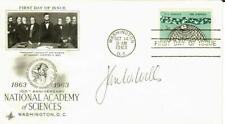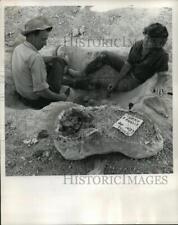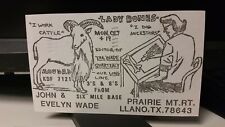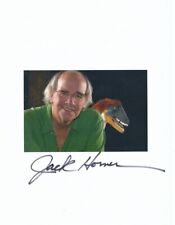|

On eBay Now...
"Paleontologist" John W Wells Signed FDC Dated 1963 For Sale

When you click on links to various merchants on this site and make a purchase, this can result in this site earning a commission. Affiliate programs and affiliations include, but are not limited to, the eBay Partner Network.

"Paleontologist" John W Wells Signed FDC Dated 1963:
$174.99
Up for sale "Paleontologist" John W Wells Hand Signed First Day Cover Dated 1963.
ES-1889 John West Wells (July 15, 1907 – January 12, 1994) was an focused his research on corals.He was notable for, among other things, proving that the rotational period of the earth undergoes periodic changes. The National Academies of Science said that Wells "made an indelible mark on the world of paleontology." The Independent called Wells "the leading authority on modern and fossil corals, a noteworthy contributor on coral reefs and atolls". Wells was Professor of Geology, Ohio State University, Professor of Geology, Cornell Society, a member of the National Academy of Sciences. Wells was bom July 15, 1907, in Philadelphia, PA. He went to school in Homer, NY, 20 miles northeast of Ithaca. He took his B.S. degree at the University of Pittsburgh, majoring in chemistry. However he soon became fascinated by geology, under the guidance of Ransom E. Sommers and Henry Leighton. Wells became an instructor of geology at the University of Texas from 1929-1931, whilst studying for his M.A. from Cornell University in 1930, with a special interest in paleontology. He took his Ph.D. from Cornell in 1933 under Gilbert D. Harris. vDuring 1933-1934, Wells was a National Research Council Fellow, studying paleontology at the British Museum (Natural History), in London, the French National Museum of Natural History (Paris), and the Natural History Museum of Berlin. Upon his return to the U.S., Wells worked with T. Wayland Vaughan in Washington, D.C. from 1935-1937, and "looked for a job." Together they revised a volume on Scleractinia (1943). Wells taught at the State Normal School at Fredonia, New York (now SUNY) from 1937 to 1938, and then was a Professor in Geology at Ohio State University from 1938-1948. At Ohio State University, he would begin researching the history of geology. Wells served in the military in France and Germany during 1944-45 in the Office of Strategic Services, and later assisted with studies assessing war damage and in the recovery of coral literature from bombed or burning buildings in Germany. His work with OSS assessed the state of universities and museums in France and Germany, following the war. Wells returned to Cornell in 1948 as professor of geology. He served as department chairman from 1962-1965. In 1946 he began working with the U.S. Geological Survey. He was involved in research into various Pacific islands, including field work in the resurvey of Bikini Atoll (1947) and was attached to the Pacific Science Board’s Arno Atoll Expedition (1950). He would continue to identify, describe, and analyze the Recent and Tertiary corals from these and other expeditions even in his retirement. Many of his publications were the direct result of this Pacific island work. During 1954, Wells was granted a Fulbright lecturing position at the University of Queensland, spending many months studying corals of the Great Barrier Reef. This period of time would establish a productive working relationship for he and Dorothy Hill of the University of Queensland, who was the leading Australian expert on reef geology. Wells and Dorothy Hill would jointly prepare nine sections on the Coelenterata for the Treatise on Invertebrate Paleontology published in 1956. Wells would also prepare sections on Scleractinia for the Treatise. Wells' most widely read paper appeared in November 1962 and was published in Nature. Astronomers and geophysicists paid attention to his “Coral Growth and Geochronometry” paper, which demonstrated their theory that the earth's rotation was slowing down. His research indicated that there were more days in the Devonian year (400) compared with those of the modern age (365), by comparing counts of daily growth lines in corals. Wells' paper generated a great amount of research on the incremental growth of skeletal material in several groups of invertebrates J. B. S. Haldane described Wells' work in an article published in the New York Times, Professor Wells of Cornell University also has this quality. He collects ancient and modern coral. Those which grow in seas where the temperature varies much with the seasons often show annual growth rings like trees. Wells found that some also show daily ridges of growth, which can be counted with a good hand lens costing perhaps $10. Modern corals show about 365 ridges a year….Silurian corals show about 400 rings a year. As the year has probably changed little, therefore the days have been getting longer. (They are getting longer, as we know, from records of ancient eclipses, among other evidence. This is thought to be due to the braking action of the tides, both in the sea and in the earth, which is not quite rigid.) Ask anyone who does not know the answer how much the apparatus cost which proved that the number of days in the year has increased by 35 in 350 million years and he will probably guess at $10 million or so. Wells would retire from Cornell in 1973, and become Emeritus Professor. In 1975 he travelled to the Charles Darwin Research Station in the Galapagos Islands and helped identify six new species of azooxanthellate corals. John Wells' long-standing interests and research into local and cultural history, especially that of upstate New York, were able to flourish in retirement. In 1958, he published The Cayuga Bridge, a story of New York local history. The summer home on Cayuga Lake, that Wells and his wife established in 1948, would host students, colleagues, and other friends from around the world, for decades. Wells had an important collection of early works on American and European geology.


"Paleontologist" John W Wells Signed FDC Dated 1963 $174.99

John Morris Signed College Form 1870/ Autographed Geologist Paleontologist $28.99

1962 Press Photo Paleontologist John Mawby & Norma Noble found a Mammoth's leg $19.99

CB radio QSL postcard aoudad paleontologist John Evelyn Wade 1970s Llano Texas $9.79

Jack Horner- Signed Color Paperstock Photograph (Paleontologist 4 Jurassic P.) $98.00
|